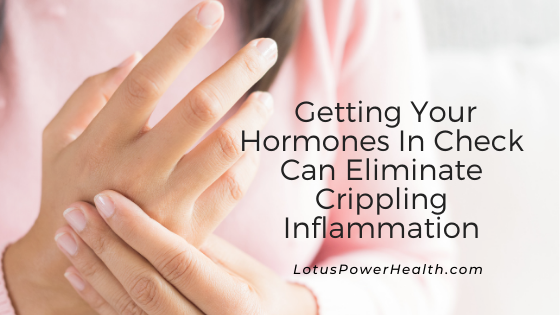You might be experiencing pain in your muscles or joints and not realize that those can be symptoms that you’re dealing with a hormonal imbalance that’s causing inflammation.
When your body has inflammation, it can cause soreness, swelling, fluid build up and pain. By eliminating the inflammation, you eliminate the pain. If you’re feeling pain anywhere in your body, start by getting your hormone levels checked.
If they’re off balance, bringing them back into balance can make you feel better again. You always want to start by getting those levels checked because unbalanced hormones can lead to an ongoing inflammation – and that can contribute to the development of some diseases.
When you get inflammation, that’s your body’s way of saying pay attention, something’s going on here that’s not right. Your body reacts to emotional injury – such as stress – or physical injury with inflammation.
It’s actually a healing response. But a problem occurs if that inflammation doesn’t go away, which is what happens when your hormones aren’t level. The inflammation can’t go away because the body doesn’t have what it needs (the right hormone balance) to heal itself.
Anything that causes your body’s hormones to fluctuate can be the cause of your inflammation. Women who are going through life changes such as menopause can struggle more with inflammation because of declining estrogen or estrogen dominance.
They can also have inflammation flares due to changes in testosterone. This is one reason why women going through menopause report a greater occurrence with achy joints.
Estrogen has anti-inflammatory properties and as you lose estrogen, you lose that anti-inflammatory boost. Estrogen isn’t the only hormonal imbalance that can cause inflammation.
If your cortisol is off balance, that can be the cause as well. When your cortisol isn’t at the level it needs to be, such as if it’s too low, you also lose anti-inflammatory properties.
If you don’t have enough cortisol and your body gets inflamed, there’s not enough of the hormone to heal the body. Cortisol is one of the hormones that jumps into the gap left by the lower levels of estrogen as a woman grows older.
It tries to pick up the slack – but as your body creates more and more cortisol, it begins to cause problems that feed into the inflammation. For example, higher levels of cortisol contribute to lowering the body’s ability to handle glucose, so you become insulin resistant.
This hurts your immune system, which then makes it more difficult for the body to heal inflammation. You can begin to experience ongoing infections, fatigue and the inability to fight off health problems. Once you restore your hormones to their proper balance, you can get rid of the inflammation that’s crippling your good health.
FREE 10-Day Optimised Health & Wellness Challenge
Discover the 5 steps of The Optimised Health Formula and how you can apply them to your life.

